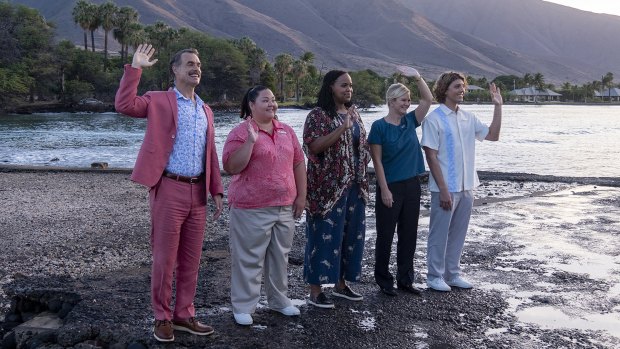This was published 2 years ago
The White Lotus and Hawaii tourism: The scary lesson the TV show teaches us
By Lee Tulloch

The White Lotus: comedy with bite.Credit: HBO
Every lockdown there's a television series that becomes compulsive viewing for hundreds of thousands of stir-crazy streaming addicts. (Remember 2020's Tiger King?)
Currently, it's The White Lotus, a satire about privilege set in a fictional Hawaiian resort, which was shot at The Four Seasons Maui at Wailea. Anyone who has stayed at a large international luxury resort will probably recognise the cast of characters, which includes two families of unlikeable, wealthy Americans and a hapless Australian resort manager, deftly played by Murray Bartlett.
It's enjoyable escapism, although probably hard to watch if you're hankering for a poolside cabana and a hotel room with a view of the ocean, though a hotel room with a view of a drainpipe would be fine by me right now.
But - and I hate to spoil anyone's fun – the frothy entertainment also has a serious undercurrent.
The entitled New Yorkers at the centre of the story splash money around like royalty dispensing favours. They have no genuine interest in the local people they encounter, except to make misguided interferences in their lives based on their own very narrow perception of the world.
No spoilers, but at the end of the season, when the Americans flounce back to their east coast mansions, at least three locals are far worse off than they were before the guests first checked their copious amounts of Gucci luggage into the hotel.
In many ways – this is the serious bit - it's a metaphor for the way tourism can have huge economic benefits for a destination while doing harm in insidious and subtle ways that negatively impact the quality of life of its year-round residents.
Hawaii's economic situation is dire without tourism. Unemployment peaked at 21.9 per cent during the pandemic. And yet, before COVID, levels weren't sustainable. In 2019, 10 million tourists visited the islands, increasing traffic by almost 15,000 cars each day and jamming roads in popular spots such as the North Shore, turning a paradise into a car park.
A recent survey by the Hawaii Tourism Authority revealed that almost two thirds of the Hawaiians sampled, having enjoyed a respite from the crowds these past 18 months, still don't want people from outside the state to visit Hawaii. It is as much to do with lack of cultural respect from visitors as it is to with overcrowded breaks.
The wellbeing of local communities has often been collateral damage when a destination becomes a booming tourist hot spot. We've seen it in so many places. Barcelona. Amsterdam. Iceland. Venice. Dubrovnik. Santorini.
The unquantifiable happiness of people has had less weight than the tangible economic gains from tourism.
How do you measure something as subjective as happiness, anyway?
The Bhutanese believe they have found a way. They assess the wealth of their country according to "Gross National Happiness" rather than Gross National Profit.
Every five years under the direction of the Centre for Bhutan Studies, survey-takers conduct questionnaires of some 8000 randomly selected households across the country, rating their satisfaction with life, using 33 statistically reliable indicators of well-being. The first survey was in 2008 and the metric was designed with Oxford University. It's now used as a model elsewhere, recognised by the OECD.
In the past few weeks, residents of 13 local government areas that make up the Central Victorian Goldfields have participated in an online survey, The Happiness Index, based on the Bhutanese model and devised by Planet Happiness, which is part of The Happiness Alliance, a non-profit organisation which promotes individual happiness and community wellbeing. It's part of the region's bid to have its gold-rush era heritage sites included on the UNESCO World Heritage List.
The Happiness Index gauges respondents' levels of satisfaction in 11 key life categories such as arts and culture, government, health, standard of living, love and companionship, work, and tourism.
Each destination taking part has its own unique URL, allowing the surveys to be localised. (Goldfields residents can go to goldfieldsworldheritage.com.au to take the survey.)
You don't have to be part of a specific tourism project to participate in the questionnaire (visit ourheritageourhappiness.org). The answers are then compared to those of all other participants worldwide, so you can see your own personal happiness status. I seem to be a bit gloomier than other people but maybe it's not a good week to be asked about happiness.
It's a useful tool in the pushback by communities against the idea that the economic benefits of tourism for some trump the wellbeing concerns of the many and brings them into the tourism planning process at an early stage.
By the way, Finland, is the happiest country in the world, according to the UN's World Happiness Report.
Why? They aim for "wellbeing rather than mere wealth".
Sign up for the Traveller newsletter
The latest travel news, tips and inspiration delivered to your inbox. Sign up now.